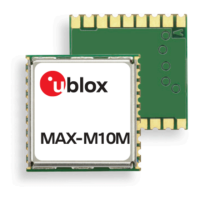MAX-M10M-Integration manual
•
The AssistNow Autonomous subsystem automatically invalidates data that has become too old
and that would introduce unacceptable positioning errors. This threshold is configurable.
• The prediction quality will be automatically improved if the satellite has been observed multiple
times. However, this requires the availability of a suitable flash memory. Improved prediction
quality also extends the maximum usability period of the data.
•
AssistNow Autonomous considers GPS, GLONASS, Galileo and BeiDou satellites only. It will not
consider satellites on orbits with an eccentricity of >0.05 (e.g., Galileo E18). For GLONASS
support, a suitable flash memory is mandatory because a single GLONASS broadcast
ephemeris contains information only for approximately 30 minutes. This is not long enough
to extend it in a usable way. Orbit information of each GLONASS satellite must be collected at
least for four hours to generate data.
3.12.4.2 Interface
Several UBX protocol messages provide interfaces to the AssistNow Autonomous feature:
•
The CFG-ANA-USE_ANA item is used to enable or disable the AssistNow Autonomous feature.
When enabled, the receiver will automatically produce AssistNow Autonomous data for newly
received broadcast ephemerides and, if that data is available, automatically provide the
navigation subsystem with orbits when necessary and adequate.
• The CFG-ANA-* configuration group also allows for a configuration of the maximum acceptable
orbit error. See the next section for an explanation of this feature. It is recommended to use the
firmware default value that corresponds to a default orbit data validity of approximately three
days (for GPS satellites observed once) and up to six days (for GPS and GLONASS satellites
observed multiple times over a period of at least half a day).
If the receiver uses flash memory, disabling the AssistNow Autonomous feature will delete all
previously collected satellite observation data from the flash memory.
• The UBX-NAV-AOPSTATUS message provides information on the current state of the
AssistNow Autonomous subsystem. The status indicates whether the AssistNow Autonomous
subsystem is currently idle (or not enabled) or busy generating data or orbits. Hosts should
UBX-22038241 - R02
3 Receiver functionality Page 59 of 92
C1-Public

